Reinforced Concrete Walls
Property
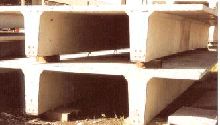
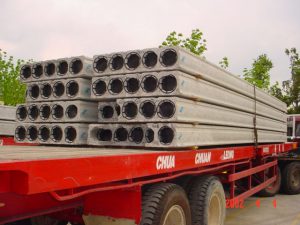
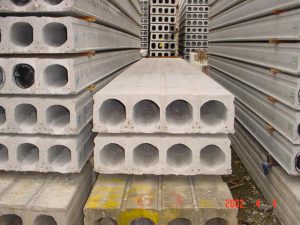
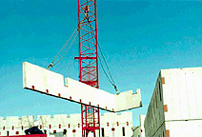
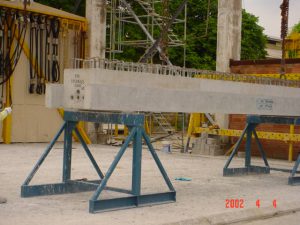
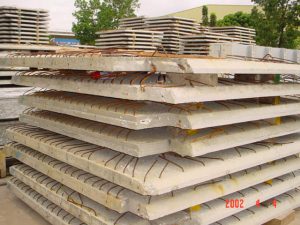
Beside used as walls, beams and columns, reinforce concrete can be used as floor slab, either cast monolithically in position in a building (in-situ) i.e. flush slab; beam and slab; drop slab; and waffle-grid slab, or can be formed of a series of reinforced precast concrete units, manufactured in a factory and brought to site i.e. hollow planks, inverted T, double T, channel, and solid wide planks.
Components
Plain concrete is made by mixing cements, fine and coarse aggregate, water and admixtures. The common practice of mixing the concrete component is based on ratio 1:2:4 proportion of cement: sand: aggregate. When reinforcing steel is placed in the forms and wet concrete mix is poured around it, the final solidified mass becomes reinforced concrete.
Cement
Cement shall be ordinary Portland Cement, rapid hardening Portland Cement (complying with SS 26), sulphate resisting Portland Cement (to BS 4027), supersulphate cement (to BS 4248) or low heat Portland blast-furnace cement (to BS4246).
According to ASTM C 150, there are 4 types of Portland cement:
| ASTM Type | Typical Use | Typical compound composition | |||
| CzS | C3S | C3A | C4AF | ||
| I | General | 45-55 | 20-30 | 8-12 | 6-10 |
| II | General, with resistance to sulphate attack | 40-50 | 25-35 | 5-7 | 6-10 |
| III | High early strength | 50-65 | 15-25 | 8-14 | 6-10 |
| IV | Sulphate resistance | 40-50 | 25-35 | 0-4 | 10-20 |
* C; CaO; SiOz; A; AlsO3; F; FezO3
Typical composition of Portland Cement:
|
Oxide Formula
|
Cement chemist’s nomenclature
|
Content (%)
|
|
SiO2
|
S
|
17-25
|
|
CaO
|
C
|
60-67
|
|
Al2O3
|
A
|
3-8
|
|
Fe2O3
|
F
|
1.5-4.5
|
|
MgO
|
M
|
0.5-4.0
|
| K2O |
K
|
0.1-1.5
|
|
Na2O
|
N
|
0.1-1.0
|
|
SO3
|
S
|
2.0-3.0
|
| LoI* |
1.5-2.5
|
|
| Free Lime |
0.5-1.5
|
|
| Insoluble residue |
0.3-1.5
|
* LoI, loss in ignition
Cements replacement
Cement shall be ordinary Portland Cement, rapid hardening Portland Cement (complying with SS 26), sulphate resisting Portland Cement (to BS 4027), supersulphate cement (to BS 4248) or low heat Portland blast-furnace cement (to BS4246).
The selection of type of cement replacement affects the physical characteristic of the final product.
Properties of different types of cements:
| Portland Cement | Ground granulated blast-furnace slag | Pulverised fuel ash | Silica fume | |
| Fineness (m²/kg) | 340 | 350 | 380 | 15000 |
| Bulk Density (kg/m³) | 1400 | 1200 | 900 | 240 |
| Density (g/cm³) | 3.1 | 2.9 | 2.3 | 2.2 |
Sand
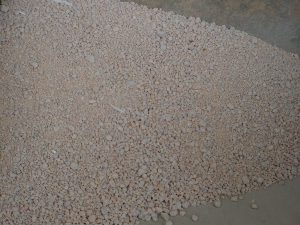
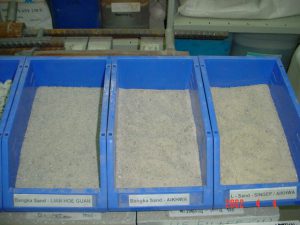
The proportion of sand to total aggregate depends on the grading of the sand as indicated by the proportion of sand passing the 600 µm sieve. It also depends on the maximum aggregates size, the workability, and the free-water/ cement ratio.
Based on mineralogical composition, sand is divided into quartz, feldspar and carbonaceous varieties. Depending upon its size, sand is classified as coarse sand (fineness modulus/ F.M: 2.90-3.20), medium sand (F.M: 2.60-2.90) and fine sand (F.M: 2.20-2.60).
Based on particle size distribution fine aggregate have been divided into 4 grades from grading zone I to grading zone IV as given in the table below.
| Sieve Designation |
Percentage passing for
|
|||
|
Grading Zone I
|
Grading Zone II
|
Grading Zone III
|
Grading Zone IV
|
|
| 10mm |
100
|
100
|
100
|
100
|
| 4.75mm |
90-100
|
90-100
|
90-100
|
90-100
|
| 2.36mm |
60-95
|
75-100
|
85-100
|
95-100
|
| 1.18mm |
30-70
|
55-90
|
75-100
|
90-100
|
| 600 micron |
15-34
|
35-59
|
60-79
|
80-100
|
| 300 micron |
5-20
|
8-30
|
12-40
|
15-50
|
| 150 micron |
0-10
|
0-10
|
0-10
|
0-15
|
Aggregates
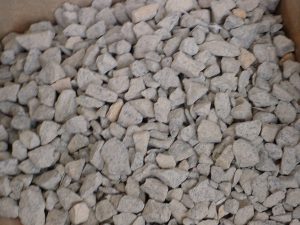
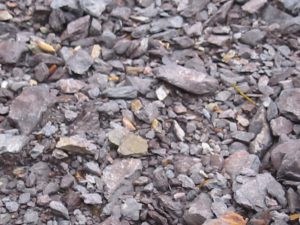

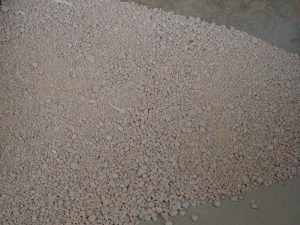

Aggregates may be classified into natural aggregate (i.e. crushed igneous, sedimentary, metamorphic rock, gravel and sand) and artificial aggregate (i.e. broken brick and blast furnance slag).
Since aggregate occupies about 75% of the total volume of concrete, its properties have a definite influence on the behavior of hardened concrete such as durability, strength, density, shrinkage, and thermal properties.
Aggregates are usually graded by size and a proper mix has specified percentage of both fine and coarse aggregate. In the BSI, fine aggregates are those which particles mainly pass a 5.0mm BS 410: 1983 test sieve and do not contain more coarse material than permitted for grading specified. Coarse aggregates are those which most particles are retained on a 5.0mm BS 410:1983 test sieve with no finer material than permitted for various sizes specified. In the ASTM system, 4.75mm (no. 4 sieve) is the nominal dividing size of coarse and fine aggregate.
Coarse aggregate can be:
- Gravel:
- Uncrushed gravel, which results from the natural disintegration of rock
- Crushed gravel
- Partially crushed gravel
- Crushed rock
- Blended coarse aggregate produced by the controlled blending of gravel and crushed rock.
Fine aggregate can be:
- Sand:
- Uncrushed sand
- Partially crushed sand
- Crushed gravel fines
- Crushed rock fines
- Blended fine aggregate
Beside fine and coarse aggregate, there is lightweight aggregate. This type of aggregate has apparent specific gravity significantly less than the normal fine and coarse aggregates. They ranged from extremely lightweight types used in insulating and non-structural concrete, to expanded shales, clays and slates used in structural concrete.
Admixtures
In addition to concrete mix, there is another material known as admixture. Admixture may be used to modify the properties of the concrete to make it better serve its intended use or for better economic reason.
The main types of admixtures are: air-entraining agent, mortar plasticizers, water-reducing agents and concrete plasticizer, superplasticizers, accelerator, corrosion inhibitors, retarders and permeability reducers.
Water
Water is required for hydration, which acts as lubricant between coarse and fine aggregates and produces a workable and economical concrete.
The water/ cement ratio (w/c) is one of the major factors influencing the strength of concrete. For proper workability the w/c ratio varies from 0.4-0.6. However, maximum strength is derived at w/c=0.4. The concrete compacted by vibrator has higher strength, even up to w/c=0.3. At w/c ratio more than 0.4, the expansion of cement on hydration is insufficient to occupy the space previously filled with water. Thus, porosity increases and strength decreases.
Almost any natural potable water that has no pronounced taste or odour is acceptable for the concrete mix. Many sources of water unsuitable for drinking may also be used. However, the level of impurities might affect the setting time of cement.
Reinforcement
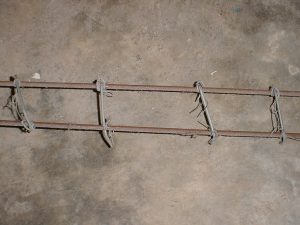
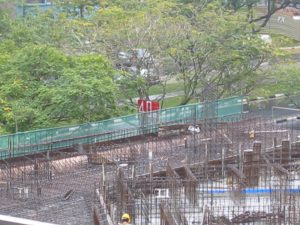
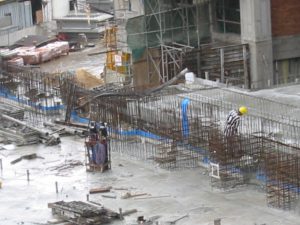
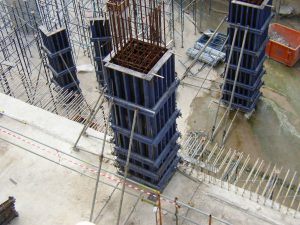
Steel reinforcement may consist of steel bars, welded wire fabric, or wires. For normal reinforced concrete the basic type of bar available in Singapore and shall comply with SS 2: 1999 are:
- Grade 250: Mild Steel bars in plain round form (R 10, R 6, R 13)
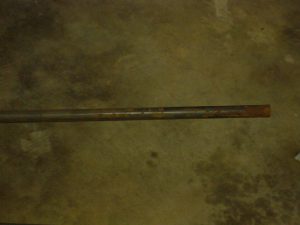
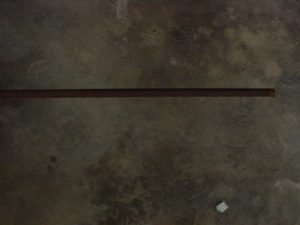
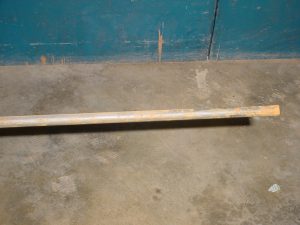
- Grade 460: High Tensile bars in ribbed/ deformed profile (T10, T13, T16, T20, T25, T28, T32, T40)
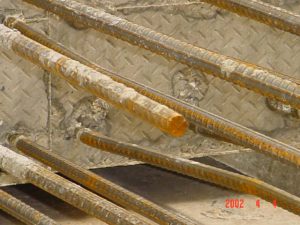
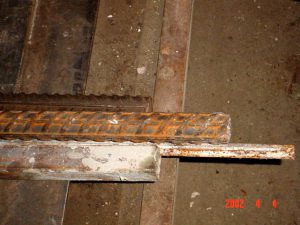
- Grade 485: Welded Mesh reinforcement (for square meshes i.e. A6, A7, A10, and rectangular meshes i.e. B12, B111, B10, etc). Depending on the design load, the spacing ranges from 100 to 200mm.
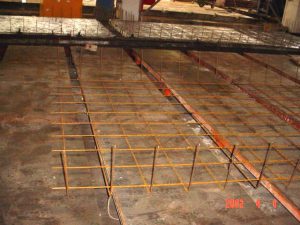
The cross sectional areaa of various bar sizes:
| Size (mm) |
Cross-sectional area (mm²)
|
Mass per metre
|
|
6b
|
28.3
|
0.222
|
|
8
|
50.3
|
0.395
|
|
10
|
78.5
|
0.616
|
|
12
|
113.1
|
0.888
|
|
16
|
201.1
|
1.579
|
|
20
|
314.2
|
2.466
|
|
25
|
490.9
|
3.854
|
|
32
|
804.2
|
6.313
|
|
40
|
1256.6
|
9.864
|
|
50
|
1963.5
|
15.413
|
a Derived from the mass per metre run, using an assumed density of 0.00785 kg/mm² per metre run
b Non-preferred size
Herewith are the properties of various reinforcement bars:
| Density at 20°C (kg/m³) | Coefficient of thermal expansion
(10-6 K-1) |
Thermal conductivity (W/mK) | Specific heat
(J /kgK) |
|
| Pure iron |
7870
|
12.1
|
78
|
455
|
| Wrought low carbon steel |
7860
|
12.2
|
. | . |
| Cast low carbon steel | . |
12.2
|
49
|
. |
| Medium carbon steel |
7860
|
12.2
|
51
|
485
|
| High carbon steel |
7860
|
11.1
|
48
|
490
|
Finishes for precast product

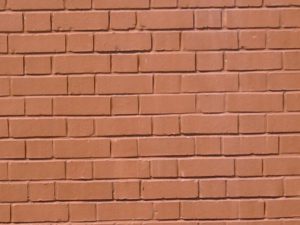

To achieve more effective construction, nowadays precaster has been adopting various finishes in the precast manufacturing, such as stone, brick, colored, rough, and textured concrete surfaces.
Clear coating for exposed concrete surface has been developed to resist weathering effect such as water ingress.
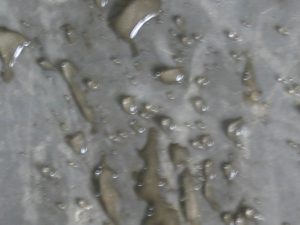
Grades
In Singapore, grades for reinforce concrete ranged from C5 to C60. These grades indicate the strength of concrete in 28 days (N/mm2). Above C30 and C40-graded concrete are commonly used for structural members such as wall cladding and intermediate floor slab. For prestressed concrete, normally C50 is preferred.
Density
The density of concrete is 2400 kg/m³, whilst for lightweight concrete is ranged between 300 and 2000 kg/ m³
Thermal Conductivity
Thermal conductivity of concrete is 1.442 W/m ºK, whilst for the lightweight concrete is ranged between 0.303 and 0.476 W/m ºK.
Coefficient Of Linear Thermal Expansion/ ºC
The dimensional stability of reinforced concrete floor decks may sometime be a cause of concern. Dimensional changes in decks can cause damage to the supporting structure and also, in some circumstances, give rise to distortion in the deck itself.
The Coefficient of Linear Thermal Expansion for reinforced concrete is ranged from 7-14 X 10-6 /ºC
Reversible Moisture Movement
0.01-0.07%